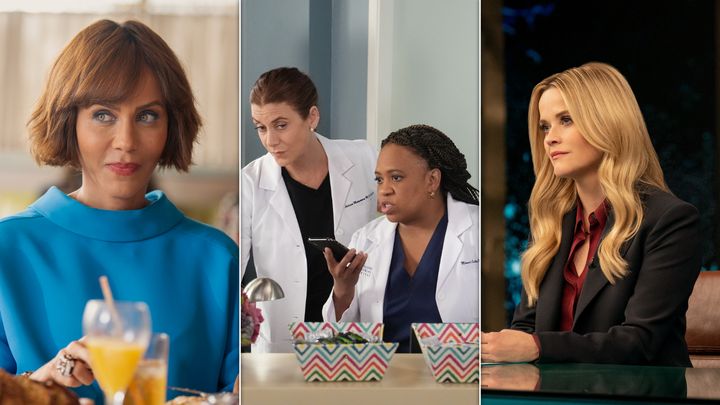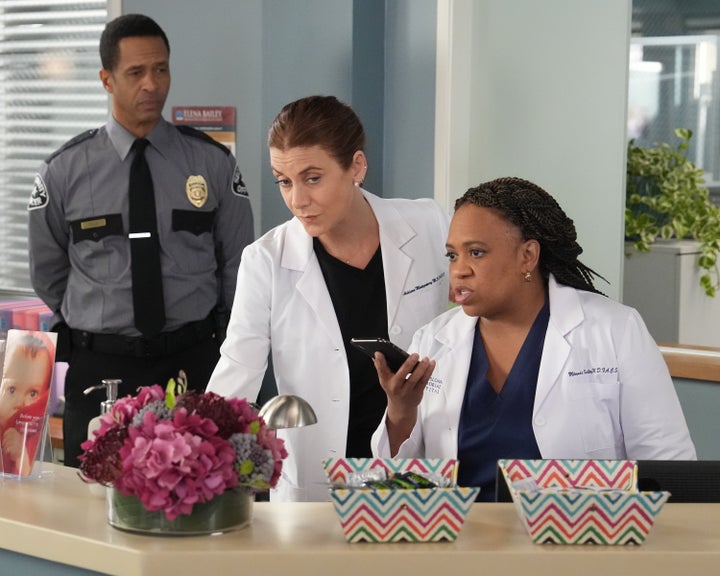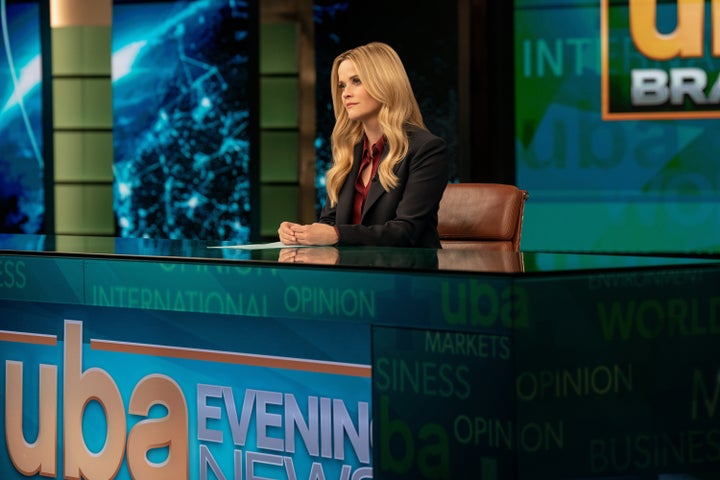
2023 was the first full year of living in a post-Roe United States, when many people across the country directly experienced the enormous ramifications of last year’s Supreme Court decision dismantling Roe v. Wade and federal abortion protections.
Pop culture can give audiences a window into these kinds of seismic moments, telling stories that help audiences understand and empathize. However, with some noteworthy exceptions, many TV shows in 2023 failed to meet the moment, according to the newest “Abortion Onscreen” report, shared exclusively with HuffPost ahead of its release Tuesday.
Compiled annually by abortion researcher Steph Herold and her colleagues at Advancing New Standards in Reproductive Health at the University of California, San Francisco, the project tracks abortion-related storylines in scripted and reality TV shows, whether they involve a character getting an abortion, disclosing a past abortion or considering an abortion.
Overall, a lot of TV shows in 2023 still failed to capture the wide spectrum of abortion stories in real life, and some backslid into regressive approaches, Herold found.
For instance, several shows this year reverted to a trope that was much more common on TV in the 1990s and early 2000s than now: the “averted abortion.” It’s when a character has an unplanned pregnancy and considers an abortion — but then either has a miscarriage or changes her mind about getting the procedure, allowing the show to sidestep further discussion of abortion.
One of the most notable examples came up on “And Just Like That,” the Max revival of HBO’s “Sex and the City.” During its second season this summer, documentary filmmaker Lisa (Nicole Ari Parker) finds out she’s unexpectedly pregnant. In a subsequent conversation with her husband Herbert (Chris Jackson), both of them tiptoe around the word “abortion,” and she dismisses the option of getting one, with no explanation. Later in the episode, she has a miscarriage.
For a franchise known for its frank discussion of women’s sexuality and other third-rail topics — including an abortion-related episode in 2001 — it was particularly dissatisfying to see “And Just Like That” go out of its way to avoid directly talking about abortion in 2023.

“These kinds of tropes and plotlines stigmatize abortion by not even having characters say the word ‘abortion.’ It’s such a low bar, this kind of stigma by avoidance,” Herold said in an interview. “It’s not that we don’t want to show miscarriages, [or] we don’t want to show pregnancy ambivalence, but that we want a range of these kinds of portrayals, where abortion isn’t just mentioned and then dropped.”
These “averted abortion” TV plotlines don’t really match up with real life, where research shows that abortion is about as common as miscarriage, and “it’s very uncommon for someone to show up at the clinic and change their mind and leave,” Herold said. “Once you’ve gone through all the hurdles of getting to the clinic, you’re going to get your abortion.”
The recurrence of these regressive storylines in 2023 came amid a drop in abortion storylines overall. After several consecutive years of gains, Herold and her team documented 49 abortion-related storylines on scripted and reality shows this year — down from 60 in 2022, a record high. Herold mostly attributes this to the monthslong strikes by writers and actors this year, and she’s hopeful that with TV shows now back in production, there will be more abortion stories on screen in 2024.
Some shows this year did thoughtfully engage with the post-Roe landscape. Several legal dramas, like Fox’s “Accused” and OWN’s “All Rise,” featured stories about people having to cross state lines to access legal abortions. The NBC workplace sitcom “American Auto” included a story arc about companies including abortion coverage as part of their employee benefits.
This season, the long-running ABC medical drama “Grey’s Anatomy” ― which often tells abortion stories, sometimes admirably and sometimes to more mixed results ― continued to explore its characters dealing with the ramifications of post-Roe America. Surgeons Miranda Bailey (Chandra Wilson) and Addison Montgomery (Kate Walsh) start a fellowship program for abortion providers from states where the procedure is highly restricted. Miranda and Addison both experience attacks and threats to their personal safety, including an anti-abortion protester throwing a brick into their clinic — reflecting how real-life abortion providers are routinely targeted while doing their jobs.

Another important issue since the fall of Roe has been access to self-managed abortion. This year, the Apple TV+ drama “The Morning Show” featured what to Herold’s knowledge may be the first in-depth TV depiction of self-managed abortion. In the show’s third-season premiere, news anchor Bradley Jackson (Reese Witherspoon) is reporting on a story involving Luna (Yuli Zorrilla), a member of a volunteer network of advocates bringing abortion pills from Mexico to patients in Texas.
When Bradley’s bosses at UBA, the show’s fictional media company, try to kill the story over potential legal concerns and political pushback, she makes an impassioned plea to keep reporting on it. After Bradley’s bosses sideline her from the story, her colleague Alex Levy (Jennifer Aniston) decides to step in for her and tries to meet up with Luna, who has now been arrested for her work.
In Alex’s subsequent news report, she underscores that medication abortions are safe and an important lifeline in places where abortion is highly difficult to access.
“What was so striking for me was that they talk about the safety of medication abortion,” Herold said. “That felt really important to counter a lot of the misinformation you see on other shows.”
Herold also appreciated that the storyline highlighted the work of activists creating a self-managed abortion network, “which we really haven’t seen on TV at all,” she said.
“Showing that it’s medically safe but legally very risky, that’s kind of a hard, nuanced balance to strike on TV, and I was impressed by that,” she said. “They had the character get arrested, showing that this activist work is really important, and it can also be really legally dangerous for people.”
Herold noted that according to the episode’s credits, the show’s writers enlisted real-life abortion providers in Texas to consult on the storyline, an approach that she hopes more shows consider in the future.

Despite these encouraging examples, Herold keeps finding some of the same longstanding pitfalls of abortion storylines on TV. Demographically, the characters in abortion stories on screen are still disproportionately younger, whiter and wealthier compared to the majority of people who get abortions in real life. In addition, the majority of real-life abortion patients are people who are already parents, something that’s rarely depicted on TV, Herold has found.
Herold said she hopes that in 2024, “there are more commitments to have more characters of color on screen, more characters who are struggling to make ends meet and more characters who are parenting.”
There’s similarly a lack of geographic diversity in abortion stories on screen. “The Morning Show” was among several shows this year that set their abortion storylines in Texas. As Herold pointed out, that’s understandable, since the state has become “the main battleground of a lot of abortion restrictions.” But she hopes TV creators and writers look to the dozens of other states where abortion access has reached a crisis point, “so people see that this is not just a Texas problem, that this is an American problem,” she said.
She’d also like to see more stories showing viewers that abortion care comes in many forms, such as self-managed abortion or the increase in abortion patients using telehealth since the pandemic. “I hope we get to see the different ways that people are able to access that kind of care,” she said.
For many years, Herold found that very few shows told stories about characters encountering the many logistical, financial and legal barriers to abortion access, such as not being able to afford an abortion, or struggling to take time off or find child care during their appointment. But in 2022, when the Supreme Court overturned Roe, there finally was a marked increase in abortion-related TV storylines that directly addressed these barriers.
Not only are those important stories to continue to tell, but they can give shows more creative opportunities, as Herold pointed out.
“We still really don’t see a lot of the nitty-gritty of what happens when someone needs an abortion,” she said. “Are they able to afford the cost of the abortion? Do they have insurance? Do they have to call someone? Do they have to tell their parents? Do they have to take time off work, find child care? How do you figure that out? How do they get the gas money? Did they take the train?”
“All of these things that are kind of the bread and butter of abortion funds and abortion logistics, there’s a ton of room for lots of drama or lots of comedy in any of those scenarios,” she said.
There’s also a need for viewers to see abortion stories in a broader range of shows. Consistent with previous years, many abortion plotlines on TV in 2023 appeared in genres where we often expect to see them, such as medical and legal procedurals. As TV continues to expand and evolve, Herold hopes creators in many more genres take on abortion storylines — in everything from sitcoms to sci-fi to historical romances — to give viewers more opportunities for a deeper emotional investment.
“On the medical and legal procedurals, it’s often like a one-off: Someone comes into the ER, or a client needs help in a legal case,” she said. “Audiences don’t get to follow that person across the season. They don’t get to develop that empathy, that parasocial relationship with them. And we know that is part of what can help audiences increase their knowledge about abortion, and increase their empathy for people who have abortions.”
Read the full report, “Abortion Onscreen in 2023,” here.
